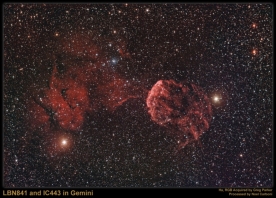The accompanying image is the Jellyfish nebula [IC443] and associated emission nebulosity [IC444] on the Gemini/Orion border. The two bright stars in this image are Eta and Mu Geminorum, Mu [Tejat] is on the left and Eta [Propus] is on the right.
The Jellyfish nebula is a supernova remnant lying 5,000 light years away. It is both very large, and very faint – an earlier Hyperstar image of the Jellyfish nebula had real difficulty in capturing the fine detail, showing just how faint it really is. Interestingly, IC443 also has a very strong SII [Sulphur 2 narrowband] emission, whereas IC444 lying just next door does not appear to show up at all in SII.
Note the nice little reflection nebula [blue region] lying within IC444. However, both IC443 and IC444 are strong emitters in the H-alpha band. In fact, there is a very strong infrared emitter in IC444 that we discovered from this image. It looks like a bright red star, and if you “zoom in” it looks like a planetary nebula. Noel found the co-ordinates for this object and by inputting these co-ordinates into Sinbad we found that this corresponded to IRAS 06185+2336!
This image is so far made up from 4 hours and 40 minutes of H-alpha using 20-minute subs, 3 hours and 40 minutes of SII using 20-minute subs, and 3 hours of RGB [IDAS filter] using 10-minute subs. Noel Carboni has combined the data expertly to produce the image you see here, but more raw data is definitely required to bring the best out of this region.
You can see that the image will benefit greatly from some more H-alpha, and perhaps a little more RGB data as well if I can get it. The weather recently has not been good for imaging, and I only managed to get the 3 hours of RGB just before fog became a major problem. Such are the joys of deep-sky imaging during the winter months.


